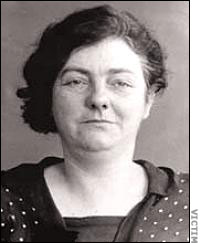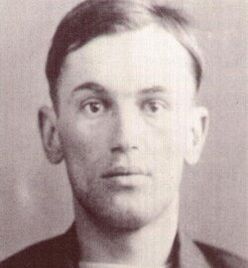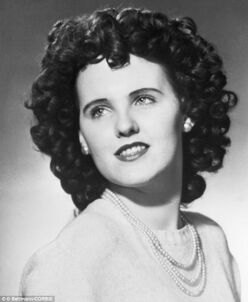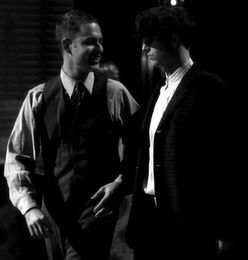"The Mad Butcher of Kingsbury Run", a.k.a. "The Cleveland Torso Murderer", is a still-unidentified serial killer who was active in Cleveland, Ohio during the 1930s.
Brief Case History
The Mad Butcher of Kingsbury Run remains unidentified to this day, as do the majority of his victims, but the first canonical victim was found on September 23, 1935, and it was estimated that he had been killed three to four weeks earlier. The last two canonical victims were found on August 16, 1938. All of the victims had been at their dump sites for various periods of time before being found. The first outstanding suspect was Dr. Francis E. Sweeney, the alcoholic first cousin of Congressman Martin L. Sweeney. Though the authorities felt that he was a viable suspect, Congressman Sweeney found out about it and, it has been suspected, made a deal with the investigating sheriff to find a better suspect. At this point, Frank Dolezal, a Cleveland resident, was arrested. He confessed to having killed Flo Polillo, the third victim, in self-defense, but later recanted on the grounds that he had been beaten into confessing by the sheriff’s jailer. As of today, the case remains unsolved.
Modus Operandi
The age and sex of all the Butcher's victims varied, but they were typically drifters or people from the lower class of society. He would usually kill them by decapitating them, sometimes after tying them up, and then mutilate the body severely post-mortem, sometimes dismembering the arms and/or legs, cutting off the genitals and removing organs, and then burn the bodies, either by using oil as an accelerant or using acid or some chemical. It was believed by the investigators that, since decapitations are very messy, the killer performed the murders someplace private and then carried the bodies to their dump sites and burned them there. In some cases, the heads were never recovered, making it possible that the Butcher kept them as a trophy or for some other purpose.
Profile
A profile made by the original investigators said that the offender was a psychopath, though probably not obviously insane. He would have had some knowledge of anatomy, maybe having worked as a physician, butcher, or hunter, and the cuts showed that he would have been very skilled at cutting flesh. As decapitations are very messy, it was believed that he had access to some private space where the murders were performed. If this was correct, the fact that the bodies would then have been carried for a long distance indicated that the killer was probably very large and strong. The killer may also have been familiar with the Kingsbury Run area. It was also theorized that the choice of victims and gruesome mutilations were a way to ensure that the victims were never identified. If this was true, the killer would profile as an organized offender.
Known Victims

Florence Genevieve Polillo.

Edward W. Andrassy.

Possible victim Elizabeth Short, a.k.a. "The Black Dahlia".
Note: The dates denote when the victims were discovered.
Confirmed
- September 23, 1935:
- An unidentified man (estimated time of death was 3-4 weeks earlier)
- Edward W. Andrassy (found close to the location of the above victim; estimated time of death was 2-3 days earlier)
- 1936:
- January 26: Florence Genevieve Polillo (estimated time of death was 2-4 days earlier)
- June 5: "The Tattooed Man" (unofficial given name; estimated time of death was two days earlier)
- July 22: An unidentified man (estimated time of death was two months earlier)
- September 10: An unidentified man (estimated time of death was two days earlier)
- 1937:
- February 23: An unidentified woman (estimated time of death was 3-4 days earlier)
- June 6: An unidentified woman (possibly one Rose Wallace; estimated time of death was one year earlier)
- July 6: An unidentified man (estimated time of death was 2-3 days earlier)
- 1938:
- April 8: An unidentified woman (estimated time of death was 3-5 days earlier)
- August 16:
- An unidentified woman (estimated time of death was 4-6 months earlier)
- An unidentified man (found close to the location of the above victim; estimated time of death was 7-9 months earlier)
Possible
- September 5, 1934: "The Lady of the Lake" (unofficial given name; was found on almost the same dump site as the first unidentified woman)
- July 22, 1950: Robert Robertson (was found decapitated; estimated time of death was 6-8 weeks earlier)
- Unspecified dates: Numerous decapitated and dismembered bodies found in boxcars and swamps located in various areas of Pennsylvania
- Note: It has also been theorized that the Cleveland Torso murder case has some connection to the c. January 15, 1947, murder of Elizabeth Short, a.k.a. The Black Dahlia.
Suspects

Dr. Francis "Frank" E. Sweeney.
- Dr. Francis "Frank" E. Sweeney
- Alcoholic
- Surgeon
- Entered voluntary psychiatric care shortly after the killings stopped
- Took a polygraph test and failed it
- Frank Dolezal
- Alcoholic Cleveland resident
- Was arrested on suspicion of killing Flo Polillo
- Confessed to killing her in self-defense
- Recanted his confessions shortly before his death, saying he had been beaten into confessing by the police
- After his death, it was found that he had six cracked ribs, which he, according to his friends, did not have when he was arrested
On Criminal Minds

The Butcher (right) as depicted in a flashback sequence in "Zoe's Reprise".
So far, the Butcher has only been referenced once on Criminal Minds, in Zoe's Reprise in which copycat serial killer Eric Olson was revealed to have partially copied the Butcher as his first known copycat murder. When he did so, he lured the victim out of a local gay bar and shot him in a park, not being able to go through with the full decapitation and dismemberment process, presumably since it was his first murder and he wanted to get it over with quickly. In the episode, it was asserted by the BAU that the original Butcher would pick up his male victims at gay bars, which was enforced through a flashback (in which the Butcher is portrayed by Ken Hurst), though there is no solid evidence that he did so. However, since his first identified victim, Edward W. Andrassy, was an alleged bisexual and had several homosexual friends, this could be a valid claim. Some of the original investigators would actually look for suspects in gay bars. The BAU and local police also incorrectly stated that the Butcher's victims were shot, dismembered, and mutilated while, in actuality, they were usually killed by decapitation.
Also, Max Allan Collins, author of the three Criminal Minds novels, has written a series of novels about the activities of Elliot Ness, one of the Butcher investigators. The second of these books, Butcher's Dozen, is about the investigation of the Cleveland Torso Murders.
The Butcher seems to have been the inspiration for Steven Parkett, the prominent unsub of X. Just like the Butcher, Parkett dismembered his victims (although he did it ante-mortem while the Butcher did it post-mortem, presumably as a forensic countermeasure), killed them by decapitation, and then disposed of their torsos, which would be the first body parts found. Also, the two shared near-identical nicknames (Parkett's nickname was The Mad Butcher of Bakersfield).
